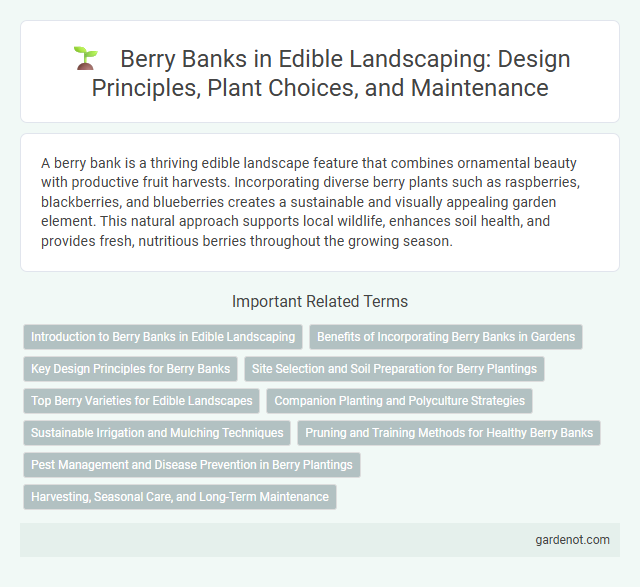A berry bank is a thriving edible landscape feature that combines ornamental beauty with productive fruit harvests. Incorporating diverse berry plants such as raspberries, blackberries, and blueberries creates a sustainable and visually appealing garden element. This natural approach supports local wildlife, enhances soil health, and provides fresh, nutritious berries throughout the growing season.
Introduction to Berry Banks in Edible Landscaping
Berry banks are specialized garden beds designed to maximize the growth and harvest of various edible berry plants such as blueberries, raspberries, and blackberries. These banks improve soil drainage, optimize sunlight exposure, and facilitate efficient harvesting in edible landscaping projects. Incorporating berry banks enhances both the aesthetic appeal and productivity of home gardens and urban green spaces.
Benefits of Incorporating Berry Banks in Gardens
Berry banks enhance garden biodiversity by attracting pollinators such as bees and butterflies, which improve fruit yields and overall plant health. They provide a sustainable source of fresh, nutrient-rich fruits, contributing to food security and reducing grocery costs. Berry banks also promote soil health through natural ground cover, preventing erosion and supporting beneficial microbial activity.
Key Design Principles for Berry Banks
Berry banks prioritize soil health, moisture retention, and sun exposure to maximize fruit yield and plant vitality. Optimal sloping ensures proper drainage while reducing erosion, creating a stable environment for berry bushes like raspberries, blueberries, and blackberries. Incorporating diverse, native pollinator-friendly plants around berry banks enhances biodiversity and supports sustainable harvests.
Site Selection and Soil Preparation for Berry Plantings
Choosing a sunny location with well-drained soil is crucial for a thriving berry bank, as most berry plants require at least six hours of direct sunlight daily. Soil testing ensures pH levels between 5.5 and 6.5, optimal for nutrient absorption, while incorporating organic matter improves soil structure and fertility. Proper site selection combined with thorough soil preparation increases berry yield and plant health in edible landscape designs.
Top Berry Varieties for Edible Landscapes
Berry banks in edible landscapes offer a diverse selection of top berry varieties such as raspberries, blackberries, and blueberries, known for their high yield and rich flavor profiles. These varieties thrive in well-drained soil and require moderate sunlight, making them ideal for sustainable, productive garden ecosystems. Incorporating berry banks enhances biodiversity while providing a continuous harvest of nutrient-rich fruit throughout the growing season.
Companion Planting and Polyculture Strategies
Berry banks thrive using companion planting and polyculture strategies that enhance soil fertility and pest control. Integrating nitrogen-fixing plants like clover or legumes supports berry bushes by improving nutrient availability and encouraging beneficial insect populations. Diverse plant species create a resilient ecosystem, reducing disease risk and maximizing space through complementary growth habits.
Sustainable Irrigation and Mulching Techniques
Berry bank cultivation benefits from sustainable irrigation methods such as drip systems, which minimize water waste by targeting root zones directly. Implementing organic mulching materials like straw or wood chips enhances soil moisture retention, reduces evaporation, and suppresses weed growth. These combined techniques promote soil health and ensure efficient water use, critical for resilient edible landscapes.
Pruning and Training Methods for Healthy Berry Banks
Pruning and training methods for healthy berry banks involve strategic removal of old or damaged canes to promote air circulation and sunlight penetration, which reduces disease risk. Maintaining a balance between fruiting and vegetative growth requires annual pruning of primocanes and floricanes to stimulate robust berry production. Training techniques such as trellising or spacing optimize canopy structure, enhance berry quality, and facilitate harvesting efficiency.
Pest Management and Disease Prevention in Berry Plantings
Berry banks in edible landscapes require integrated pest management strategies to maintain healthy plantings and optimize fruit production. Employing biological controls such as beneficial insects, monitoring pest populations regularly, and using organic pesticides reduce harmful chemical use and support ecosystem balance. Disease prevention in berry plantings hinges on selecting resistant varieties, ensuring proper spacing for air circulation, and implementing crop rotation to minimize pathogen buildup in the soil.
Harvesting, Seasonal Care, and Long-Term Maintenance
Berry banks require careful harvesting during peak ripeness to maximize flavor and nutritional value, typically from late spring through early autumn depending on the species. Seasonal care involves mulching, pruning, and fertilizing to support healthy growth and fruit production while protecting plants from pests and diseases. Long-term maintenance focuses on soil health management, periodic rejuvenation pruning, and monitoring plant vigor to ensure sustained productivity across multiple growing seasons.
Berry bank Infographic

 gardenot.com
gardenot.com